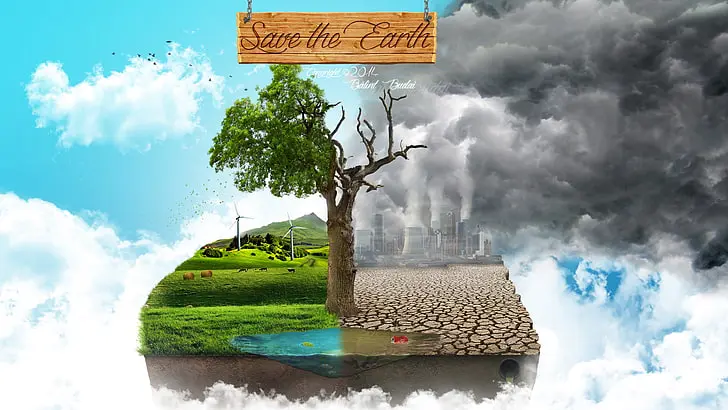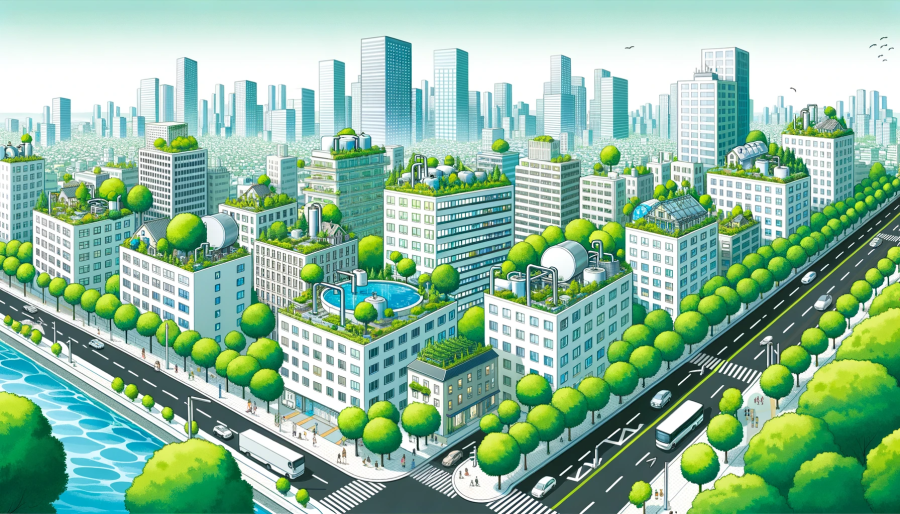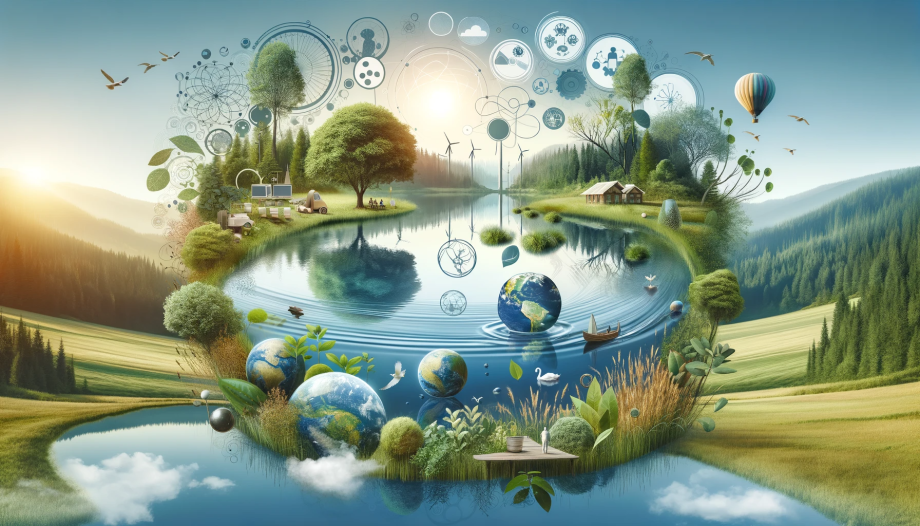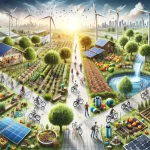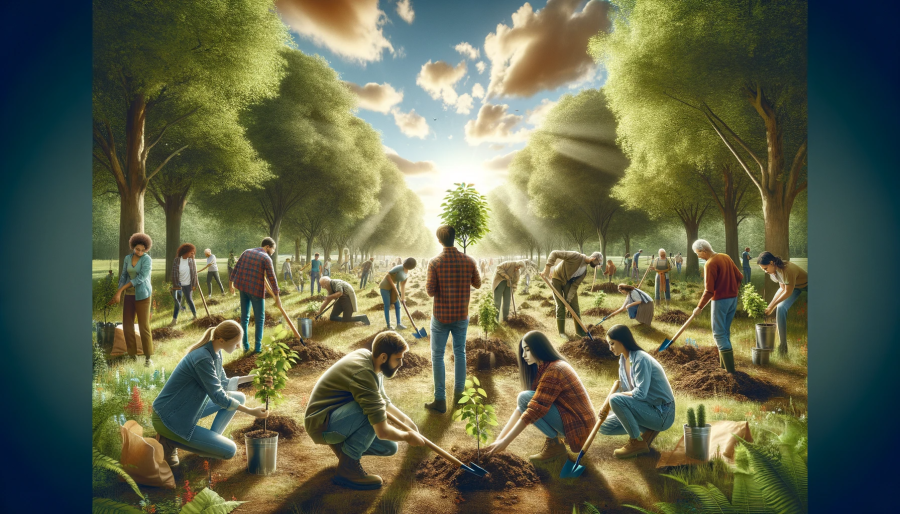
Explore our journey towards sustainability goals for a greener, fairer world. Join the eco-revolution!
Welcome to our exploration of sustainability goals! It’s a world where green dreams become actionable plans.
Here, we’re charting the course for a future that’s not just survivable, but thriving and just.
So, let’s roll up our sleeves and dive into the hows and whys of crafting a sustainable tomorrow, together.
Sustainability Goals Key Takeaways:
Understanding Sustainability Goals
Dive into the heart of sustainability goals, where we pledge to nurture our planet for today and safeguard it for tomorrow.
These goals shape a future where environmental care, economic growth, and social equity coexist in harmony.
Let’s explore this crucial balance.
The Essence of Sustainability Goals
What exactly are sustainability goals? They are like a pact we make with our world to ensure a vibrant future.
They’re about balancing our current needs with those of tomorrow, and not just for us, but for all life on Earth.
It’s a roadmap to a more sustainable future where economic growth doesn’t come at the expense of our planet.
Climate Action and Environmental Impact
Central to sustainability goals is the fight against climate change.
This means taking a hard look at our environmental impact and finding ways to reduce our carbon emissions.
Adopting sustainable practices with targets and indicators now can lead to a significant decrease in our collective carbon footprint.
Renewable Energy and Sustainable Practices
Transitioning to renewable energy sources is a vital piece of this puzzle.
Solar panels, wind turbines, and other forms of clean energy are key to reducing greenhouse gas emissions.
These actions lead to a greener future, aligning with international cooperation efforts like the Paris Agreement.
Circular Economy: A Model for the Future
Sustainability goals encourage us to embrace a circular economy, where we minimize waste and make the most of our natural resources.
This shift is essential for protecting resources for future generations and creating sustainable cities and agriculture.
Corporate Responsibility and Social Equity
The path to a greener future also includes the pivotal role of businesses and the private sector.
It’s about more than just profit. It’s about making decisions that factor in social impacts, public health, and long-term sustainability.
It’s about ensuring that social equity is woven into the fabric of our daily lives and business practices.
A Guide for Tomorrow
In this ultimate guide, we’ll explore how to lay the groundwork for sustainable growth that respects the balance of nature while fulfilling our basic needs.
This is our journey towards a future that is not just survivable but thriving for all.
The Roots and Rise of Sustainability Goals
Trace the origins of sustainability goals to a global commitment that sparked a transformative movement.
Leaders worldwide united with a shared vision: to forge a future that’s environmentally sound, socially just, and economically viable for all.
Join us as we unfold this pivotal journey.
A Global Promise for a Healthier Planet

Decades ago, global leaders planted the seeds for a revolution in how we treat our world.
They set ambitious goals with a 2030 horizon, determined to heal our planet.
These goals are not just lofty ideals; they are actionable objectives that aim to eliminate poverty, bridge the gap of inequality, and cool down the climate crisis.
17 UN-SDG Strategy Goals
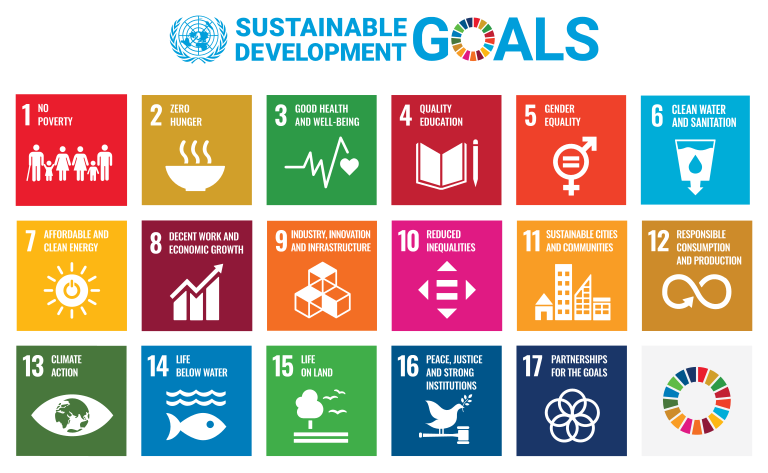
The United Nations Sustainable Development Goals (UN-SDGs) are a blueprint for prosperity, for the planet, and its people.
Adopted by nations worldwide, these SDG goals aim for a more inclusive and sustainable future. Let’s break down their strategy.
The Sustainable Development Goals (SDGs) or Global Goals are a collection of seventeen interlinked objectives designed to serve as a “shared blueprint for peace and prosperity for people and the planet, now and into the future.” Wikipedia
National Commitments and Global Impact
Nations are aligning with SDGs to transform our world.
Developed and developing countries alike are setting national targets, using indicators to track progress, and aiming to improve the lives of their population.
Progress and Challenges
The journey toward these goals is a mix of progress and hurdles. Reports show varying percent achievements across different regions, emphasizing the need for a united, high-level effort to meet these ambitious agendas.
Sustainability Goals: A Blueprint for Action
The Blueprint to End Poverty and Inequality
These goals serve as a blueprint for countries around the world to create strategies that ensure economic prosperity without sacrificing our environment.
They emphasize the importance of sustainable cities, responsible consumption, and the creation of green jobs as pillars of a new, sustainable economy.
Climate Change: The Core of Sustainability Goals
Addressing the Climate Emergency
At the heart of these goals lies the commitment to tackle climate change.
This means bold steps toward reducing carbon emissions, shifting to sustainable transportation, and fostering international cooperation.
It’s a commitment to not just slow down global warming but to usher in a new era of climate solutions that benefit all.
Environment First: Our Planet’s Health
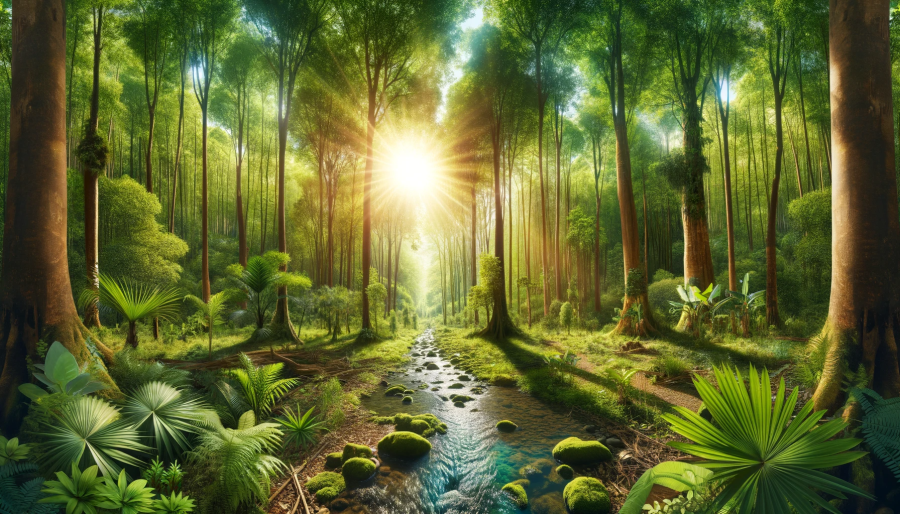
Our Earth, a mosaic of life, faces unprecedented risks due to our actions.
We’re drawing more from nature than it can replenish.
It’s as if we’re continually spending beyond our means, and the debt we’re accruing is one of environmental degradation.
To realign our relationship with the planet, we must prioritize its health.
Sustaining Terrestrial and Aquatic Life
The balance of ecosystems hinges on every species and habitat.
Protecting this balance means reducing pollution, adopting waste management strategies, and practicing responsible land use.
It’s about nurturing biodiversity and ensuring our natural resources are preserved for marine life and terrestrial creatures alike.
A United Stand Against Climate Change
Slowing the tide of climate change is critical. This involves reducing the carbon emissions that contribute to global warming.
Embracing renewable energy sources, such as solar panels and wind turbines, is key.
Additionally, promoting energy efficiency in our homes, businesses, and industries can lead to significant reductions in energy consumption, fostering a cooler, more sustainable planet.
Our world is full of life. But it’s at risk. We use more than what Earth can give back. That’s not a good thing. It’s like spending more money than you earn. Sooner or later, you run out.
Climate Action: Time to Cool Down
We’ve got to slow down climate change. How? By cutting down on gases that warm our planet.
This can be done by using energy from the sun, wind, and water. We can also get smart about saving energy in our homes and factories.
Economic Perks of Going Green
Going green saves money. Think about it. Using less energy means smaller bills.
And when we use things without wasting them, we spend less.
Adopting sustainable practices is not only eco-friendly but also economically savvy.
Using less energy translates directly to lower utility costs, and being resource-conscious can significantly cut down expenses.
It’s like finding a way to do more with less.
The Economic Upside of Sustainable Living
Sustainable living does more than just conserve the environment—it’s kind to your wallet.
By reducing energy usage through efficiency measures, like insulating homes or opting for LED lighting, households and businesses can enjoy substantial cost savings.
Green Careers and Economic Growth
The shift toward sustainability is also a powerful job creator.
The growth of the green sector, spanning from clean energy to sustainable agriculture, opens up new avenues for employment.
These roles often offer the added benefit of being future-proof, contributing to a resilient and thriving economy.
As we continue this series, we’ll delve deeper into the far-reaching influence of sustainability on our daily lives, the corporate world, and overall economic health.
Stay with us as we explore the many facets of a sustainable future.
The Social and Business Angle
Discover how sustainability intertwines with our social fabric and business ethos.
In this segment, we delve into the tangible benefits that sustainable practices yield for communities and economies, highlighting the synergy between green initiatives and societal progress.
Healthier Communities, Fairer Societies
Sustainability reaches beyond the greenery we plant or the energy we save; it’s deeply rooted in the well-being of our communities.
Clean air, access to clean water, and green spaces are not just environmental concerns, they are the pillars of public health.
When these resources are available to everyone, it fosters a society where health is a shared value, not a privilege.
Equality and Resource Sharing
True sustainability seeks to democratize access to resources, ensuring that clean energy and sustainable food sources are accessible to all, supporting a fairer society.
It’s about dismantling barriers so that every community, regardless of geography, can enjoy the benefits of a sustainable lifestyle.
The Role of Business in Shaping the Future
Businesses hold a key to driving sustainability forward.
When a company embeds environmental care into its core values, it not only enhances its reputation but also sets a precedent for industry-wide change.
This proactive approach to sustainability builds a brand that consumers trust and support.
Proactive Adaptation: The New Business Standard
For businesses, sustainability isn’t just about managing risks—it’s about embracing them as opportunities for innovation.
Forward-thinking companies are redefining their practices to be more adaptable, ensuring they’re not just surviving but thriving in an evolving economic landscape shaped by sustainability.
Innovation and Action
In the realm of sustainability, innovation and action are the catalysts for change.
This section unveils how inventive approaches and decisive actions are driving the sustainability movement, transforming ideals into real-world impact.
Innovation and action fuse together, becoming the engines of progress in sustainability. Let’s explore two vital subsections that capture the essence of this dynamic duo.
Catalyzing Change Through Technological Breakthroughs
Technological innovation is at the forefront of sustainability.
It’s about harnessing the power of renewable energy sources, improving energy efficiency, and developing new materials that reduce our environmental footprint.
This subsection will spotlight the game-changing technologies that are making a sustainable future a tangible reality.
Collective Efforts for a Sustainable Tomorrow
Action on sustainability isn’t a solo mission; it’s a collective endeavor.
Here, we focus on the power of collaboration – from international cooperation to local initiatives – and how they play a pivotal role in implementing sustainability goals.
We’ll explore the synergy between diverse stakeholders working towards a common purpose: a healthier planet and a more equitable society.
In our final part, we’ll see how new sustainability ideas and working together can make sustainability a reality. We’ll talk about how governments, businesses, and each of us can take action. Don’t miss it!
Innovating and Taking Action

Embark on a journey through the dynamic landscape of sustainability, where innovation sparks action and action fuels progress.
In this crucial chapter, we explore the transformative power of creative solutions and collective willpower in shaping a sustainable future.
Creativity Fuels Change
In the face of sustainability’s vast challenges, creative thinking becomes essential.
It’s not just about finding solutions but reimagining our approach to living on this planet.
Creative challenges spark innovation, leading to breakthroughs like biodegradable materials and water-saving technologies, which can have a profound environmental impact.
Tech for Tomorrow
Advances in technology are pivotal in our quest for sustainability.
From electric vehicles reducing our reliance on fossil fuels to smart thermostats slashing energy consumption, these innovations are reshaping our impact on the planet.
They represent the tools we need to build a future where technology and ecology coexist seamlessly.
Everyone’s Role in Sustainability
Unveiling the collective power in our pursuit of sustainability, we see that each of us holds the key to change.
This section spotlights the individual actions and shared responsibilities that make a sustainable future possible for all.
We all can do something for a greener world. It starts with knowing why it matters and then taking steps, like recycling and saving energy.
Together We’re Stronger
Major shifts towards sustainability are catalyzed by collaboration. When governments enact supportive policies, businesses innovate for efficiency, and communities mobilize for action, the collective impact can be monumental.
It’s through this united effort that the path to a sustainable future is paved, highlighting the importance of each sector’s contribution to the overall goal.
-
The Role of Education in Promoting Sustainability
- Educating the Young: Shaping Future Leaders Understanding sustainability starts with education. Schools across the United States are embedding environmental sustainability into their curricula, preparing students to be conscientious citizens who value sustainable living.
- Lifelong Learning: Sustainability in Adult Education Sustainable solutions often stem from informed decisions. Adult education programs are now offering courses on sustainable practices, showing that it’s never too late to contribute to a greener future.
-
Innovative Urban Planning for Sustainable Cities
- Green Architecture: Building with Nature in Mind Green buildings, with features like rainwater harvesting and LEED certification, play a crucial role in reducing a city’s carbon footprint and promoting long-term sustainability.
- Smart Cities: Technology’s Role in Urban Sustainability Cities are turning to artificial intelligence and green technology to manage resources efficiently, demonstrating a paradigm shift towards sustainability at a global level.
-
The Impact of Agriculture on Sustainability
- Sustainable Farming Techniques: A New Era for Food Production Sustainable agriculture practices, like organic farming, ensure food security while maintaining the health of our soil and water.
- The Importance of Biodiversity in Agriculture Biodiversity is the backbone of sustainable agriculture, supporting ecosystem health and resilience, essential for a sustainable food chain.
-
The Influence of Policy on Sustainability Goals
- Legislation and Sustainability: Crafting Laws for a Greener Future Policy changes are driving forces for sustainability initiatives. With new regulations, governments can lead the way toward a sustainable transition, emphasizing the importance of renewable sources and sustainable business practices.
- International Policies: Harmonizing Global Sustainability Efforts International cooperation is essential for environmental challenges that know no borders. Agreements like the Paris Agreement show how global consensus can lead to unified climate action.
-
Consumer Behavior and Sustainable Choices
- The Power of the Green Consumer: Demand Influences Supply Consumers are demanding more eco-friendly products, which influences companies to adopt sustainable solutions in their supply chain and production processes.
- Ethical Consumption: Understanding the Lifecycle of Products Awareness of product lifecycles encourages consumers to opt for items that have a positive impact, driving economic growth in the green sector.
-
Investing in Sustainability: Financial Aspects
- Green Finance: Funding the Future of Our Planet Green finance is emerging as a pivotal role in supporting projects that contribute to sustainable development and offer long-term economic viability.
- Sustainable Investment Trends: Where Money Meets Morality Investors are increasingly attracted to companies that prioritize environmental, social, and governance (ESG) criteria, which often leads to sustainable growth.
-
The Intersection of Technology and Sustainability
- Artificial Intelligence and Sustainability: The Smart Revolution Artificial intelligence is revolutionizing our approach to sustainability, optimizing everything from energy usage to minimizing waste.
- The Role of Data in Driving Sustainable Decisions: Big data analytics is critical in understanding environmental impact and informing decision-making processes for sustainability strategies.
-
Cultural Perspectives on Sustainability
- Local Traditions: Integrating Indigenous Wisdom: Indigenous practices play a crucial role in environmental stewardship, offering insights into sustainable living that have been honed over centuries.
- The Global Tapestry: Cultural Contributions to Sustainability: Cultural diversity brings a richness of ideas and practices to the table, enhancing international cooperation and sustainability initiatives.
-
Health, Well-Being, and Sustainability
- Public Health Initiatives A Sustainable Approach: Sustainable solutions in public health can lead to improved well-being and economic opportunities, as healthy societies are more productive.
- Mental Health and Environmental Connection: The link between environmental sustainability and mental health is becoming clearer, with studies showing the positive impacts of green spaces on human health.
-
The Future of Energy: Beyond Solar and Wind
- Emerging Renewable Energy Sources: Beyond solar and wind, new renewable energy sources are being explored, promising to further diversify our energy transition strategies.
- The Role of Nuclear in the Sustainable Energy Mix: Nuclear energy offers a potent alternative for a sustainable energy mix, with advancements in safety and waste management making it a more viable option.
Conclusion: Our Collective Journey to Sustainability
In closing, we reflect on the interconnected roles and innovative strategies that define our shared pursuit of sustainability. This journey is not a solitary one but a collective endeavor that binds us all.
Recap of the Sustainability Voyage
Here, we’ll revisit the key milestones we’ve covered, emphasizing how each facet of sustainability is crucial to the overall mission.
In our sustainability voyage, we’ve navigated through the essential elements of a greener future.
From the roots of global sustainability goals to the innovative strides in technology and collective action, each step has been pivotal.
We’ve delved into the economic and social layers, highlighting how green practices benefit communities and economies alike.
We’ve recognized the role of education, urban planning, and policy in fostering sustainability, and examined how consumer choices and financial investments can drive significant change.
This journey underscores the interconnectedness of our actions and their impact on the planet’s health and our collective well-being.
Looking Ahead: The Sustainable Legacy We Leave
Our actions today craft the legacy for tomorrow. We’ll discuss the importance of continuing this momentum and the enduring impact our choices have on future generations and the health of our planet.

